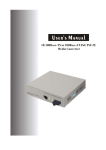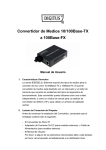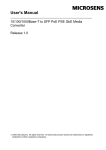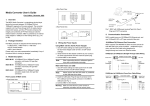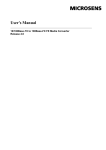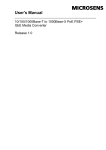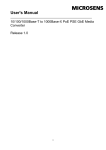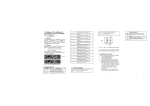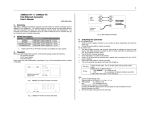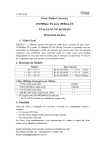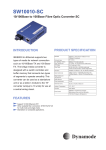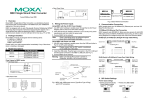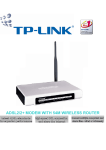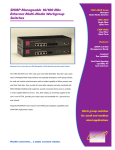Download CFPS1300 User`s Manual
Transcript
User's Manual PoE PSE (Power Sourcing Equipment) Bridge Media Converter Fast Ethernet 10/100Base-TX(RJ-45) To 100Base-FX(ST/SC/LC) 10. PoE PSE TP-Fiber Technical Specifications • Standards • • • • : IEEE802.3u 10/100Base-TX, 100Base-FX IEEE802.3af Power over Ethernet UTP Cable : Cat. 5 cable and up to100m Fiber Cable : 50/125, 62.5/125 or 100/140µm multi-mode 8.3/125, 8.7/125, 9/125 or 10/125µm single-mode PSE Power Feeding Supports : “Endpoint” via TP pin 1, 2, 3, 6 LED Indicators : POWER, PoE, TP LNK/ACT, 100, FX LNK/ACT, FDX/COL,4W,7W,15.4W Data Transfer Rate : Speed 100Mbps 10Mbps Forwarding Rate 148,800 PPS 14,880 PPS PoE PSE Bridge Media Converter User's Manual Release 2.0 • Flow Control : IEEE802.3x compliant for full duplex Backpressure flow control for half duplex • Power Requirement : AC Line: 100-240V 50-60Hz • Power Consumption : 24W • Ambient Temperature : 0° to 50°C • Humidity : 5% to 90% • Dimensions : 40(H) × 158(W) × 133(D) mm • Complies with FCC Part 15 Class A and CE Mark Note: For connecting this device to Router, Bridge or Switch, please refer to the corresponding device's Technical Manual. Part Number: 620-1031-000 Release Date: May, 2005 10 User's Manual PoE PSE (Power Sourcing Equipment) Bridge Media Converter Fast Ethernet 10/100Base-TX(RJ-45) To 100Base-FX(ST/SC/LC) 7. LED Description LED FX LNK/ACT FX FDX/COL TP LNK/ACT TP 100 PWR Color Function Lit when fiber connection is good Green Blinks when fiber data is present Lit when full-duplex mode is active Amber Off when half-duplex is active Blinks when collision is present Lit when TP connection is good Green Blinks when TP data is present Lit when TP speed is 100Mbps Green Off when TP speed is 10Mbps Green Lit when +5V power is coming up Green 4W Green Lit when PoE feeding power is active Lit when PoE feeding power is disrupted (In case of overtemperature/overcurrent ) Light when PD Class Type is Class 1 7W Green Light when PD Class Type is Class 2 15.4W Green Light when PD Class Type is Class 0 or 3 PoE PSE-TP Red 8. Connecting to TP, Fiber Device Converter TP Port 10/100TP Converter Fiber Port 100FX AUTO, FORCE selectable: Bit 1, 2, 3 of S1 a. AUTO: 10/100 NWay Auto-negotiation b. FORCE: 100 or 10, FDX or HDX 100Mbps duplex selectable: Bit 5 of S1 a. FDX for 100FDX fiber link partner, default b. HDX for 100HDX fiber link partner TP-AUTO 100 FDX LFP EN FDX-FX PoE S1 1 RESET 2 3 TP-FORCE 10 HDX 4 5 6 LFP HDX-FX PoE DIS DIS 1. Overview IEEE802.3u 100Mbps Fast Ethernet supports two types of media, 10/100Base-TX and 100Base-FX, for network connection. LFP (Link Fault Pass Through) feature enhances the TP-Fiber Link integrity and conformity. Either one of TP or Fiber port is in link-fail state, the LFP converter forces the other port to be at link-disabled state. The PSE media converter complies with IEEE 802.3af, its advanced autosensing algorithm enables providing power devices (PD) discovery, classification, current limit, and other necessary functions. It also supports high safety with short circuit protection and power-out auto-detection to PD. 2. Model Description Model PoE PSE TP-Fiber Power Description AC Line: 100-240V 50-60Hz The 100Mbps Fiber Transceiver Wavelength 1310nm 1310nm 1550nm ∗:Any other fiber model, such as MT-RJ is available upon request. Single Fiber Model TX, RX Wavelength 1310nm Single-Mode 20Km TX (Transmit) 1310nm ∗ 40/60Km models are option RX (Receive) 1550nm 1550nm Single-Mode 20Km TX (Transmit) 1550nm ∗ 40/60Km models are option RX (Receive) 1310nm ST/SC/LC multi-mode 2Km SC/LC.S05/S20/S40/S60Km single-mode SC/LC.S80/S100Km single-mode Note: The 1310nm and 1550nm models must be installed in pairs, i.e., install 1310nm model at one end and 1550nm model at the other one. Fig. 12 Reset button and S1—Bit 1, 2, 3, 4, 5, 6 Configuration and Setting 8 1 3. Checklist Before you start installing the Converter, verify that the package contains the following: ⎯ The PoE PSE TP-Fiber Converter ⎯ AC Power Cord ⎯ This User's Manual Please notify your sales representative immediately if any of the aforementioned items is missing or damaged. 10/100 Switch TP ●● ● Installing the Converter PSE TP-Fiber Converter with Powered Device (PD) ⇒ Connect the PSE media converter to an AC power source ⇒ Install the TP media cable to the IEEE 802.3af PD converter (See Fig. 2) Note: It can work as a pure converter that connects to the non-PoE converter. ⇒ Install the media cable for network connection ○ ⇒ Verify that the AC input conforms to your country AC power requirement and then insert the power plug ⇒ Ensure that the power of PSE device is turned on ⇒ Install the media cable for network connection Default: AUTO AUTO or FORCE setting, see Fig. 12 S1—Bit 1 Attach TP Cat. 5 cable to TP port, and the distance TP Port can be up to 100m. Use the straight-through cable to connect the switch or workstation, the 10/100 TP port can support AUTO MDI-X sensing. Fiber Default: 100FDX Port "100FDX"/"100HDX" setting, see Fig. 12 S1—Bit 5 2 ● ● LFP C Fiber ● Cable TP ● A B TP ○○ C Fiber Cable 10/100 Switch Remote Station LFP ●○ TP ○ ● Fig. 10 The status as TP Cable A is broken 10/100 Switch A B LFP TP ○ Warning: Remote Station Fig. 9 Normal status via a pair of LFPs 10/100 Switch LFP 4. A B LFP 10/100 Switch ○○ 10/100 Switch Remote Station ○ ● LFP C Fiber Cable TP ○○ Fig. 11 The status as Fiber Cable B or C is broken Note : ● ○ indicates LNK/ACT LED Lit indicates LNK/ACT LED Off Warning: The LFP ( Link Fault Pass Through) function works only when both two converters own this capability in pairs. Furthermore, both LFP converters should be supplied only by the same manufacturer/vender. The connection coming from LFP converters with odd models or non-LFP converters will cease the LFP function. 7 TX-1310/RX-1550 PoE PSE TP-to-100FX WDM Single Fiber TX-1550/RX-1310 Single Fiber PoE PSE TP-to-100FX WDM SingleFiber TP TP AC PoE PD TP AC TP PoE PD Fig. 8 Power from PSE to PD Fig. 1 The View of PoE PSE Media Converter 6. Link Fault Pass Through This media converter supports link fault pass through (LFP) in TX/FX converter application. Link status on one port is propagated to the other port to notice the remote nodes. If TP port is unplugged, this converter stops transmission on fiber port. This causes the remote fiber node link to fail. LED shows the link failure on both TP and fiber ports. If fiber link fails, this converter restarts auto-negotiation on TP port but always stays in the link failure state. This causes the remote TP node link to fail. LED also shows the link failure on both TP and fiber ports. Refer to Fig. 9 shown below for the normal status when the link succeeds. Also refer to Fig. 10 and Fig. 11 for the erroneous status when TP Cable A, Fiber Cable B or Fiber Cable C fails to connect. Note: Link fault pass through (LFP) function only takes effect as S1-Bit4 (see Fig. 12) is enabled. Disabled S1-Bit4 will turn this media converter into a general one. RJ-45 Jack Fiber Optic 100FX Fiber Network Cat. 5 Cable PD Device (Refer to Fig. 6) Fig. 2 Connection among PSE Ethernet Switch, Fiber and TP Cables 100FX Fiber Network RX TX TX RX PoE PSE TP-to-100FX Converter AC PoE PD or PoE Splitter Fig. 3 PSE to PD or PoE Splitter 6 3 Note: IEEE802.3af assigns pairs on the RJ-45 connector and Cat.5 cable of Endpoint PSE. Endpoint : -48V via TP pin 1, 2, 3, 6 5. Fig. 4 PoE PSE Media Converter Front Panel WDM Single Fiber Model The TP-Fiber converter is specially designed with an optic Wavelength Division Multiplexing (WDM) model that can transport bi-directional full duplex signal over a single fiber simultaneously. Single Fiber Model 1310nm Single-Mode 20Km ∗ 40/60Km models are option 1550nm Single-Mode 20Km ∗ 40/60Km models are option TX, RX Wavelength TX (Transmit) 1310nm RX (Receive) 1550nm TX (Transmit) 1550nm RX (Receive) 1310nm Note: The 1310nm and 1550nm models must be installed in pairs, i.e., install 1310nm model at one end and 1550nm model at the other one. Fig. 5 PoE PSE Media Converter Rear Panel Fig.7 PoE PSE WDM Single Fiber Converter Front Panel Fig. 6 Endpoint PSE RJ-45 Male Connector 4 5 Note: IEEE802.3af assigns pairs on the RJ-45 connector and Cat.5 cable of Endpoint PSE. Endpoint : -48V via TP pin 1, 2, 3, 6 5. Fig. 4 PoE PSE Media Converter Front Panel WDM Single Fiber Model The TP-Fiber converter is specially designed with an optic Wavelength Division Multiplexing (WDM) model that can transport bi-directional full duplex signal over a single fiber simultaneously. Single Fiber Model 1310nm Single-Mode 20Km ∗ 40/60Km models are option 1550nm Single-Mode 20Km ∗ 40/60Km models are option TX, RX Wavelength TX (Transmit) 1310nm RX (Receive) 1550nm TX (Transmit) 1550nm RX (Receive) 1310nm Note: The 1310nm and 1550nm models must be installed in pairs, i.e., install 1310nm model at one end and 1550nm model at the other one. Fig. 5 PoE PSE Media Converter Rear Panel Fig.7 PoE PSE WDM Single Fiber Converter Front Panel Fig. 6 Endpoint PSE RJ-45 Male Connector 4 5 TX-1310/RX-1550 PoE PSE TP-to-100FX WDM Single Fiber TX-1550/RX-1310 Single Fiber PoE PSE TP-to-100FX WDM SingleFiber TP TP AC PoE PD TP AC TP PoE PD Fig. 8 Power from PSE to PD Fig. 1 The View of PoE PSE Media Converter 6. Link Fault Pass Through This media converter supports link fault pass through (LFP) in TX/FX converter application. Link status on one port is propagated to the other port to notice the remote nodes. If TP port is unplugged, this converter stops transmission on fiber port. This causes the remote fiber node link to fail. LED shows the link failure on both TP and fiber ports. If fiber link fails, this converter restarts auto-negotiation on TP port but always stays in the link failure state. This causes the remote TP node link to fail. LED also shows the link failure on both TP and fiber ports. Refer to Fig. 9 shown below for the normal status when the link succeeds. Also refer to Fig. 10 and Fig. 11 for the erroneous status when TP Cable A, Fiber Cable B or Fiber Cable C fails to connect. Note: Link fault pass through (LFP) function only takes effect as S1-Bit4 (see Fig. 12) is enabled. Disabled S1-Bit4 will turn this media converter into a general one. RJ-45 Jack Fiber Optic 100FX Fiber Network Cat. 5 Cable PD Device (Refer to Fig. 6) Fig. 2 Connection among PSE Ethernet Switch, Fiber and TP Cables 100FX Fiber Network RX TX TX RX PoE PSE TP-to-100FX Converter AC PoE PD or PoE Splitter Fig. 3 PSE to PD or PoE Splitter 6 3 3. Checklist Before you start installing the Converter, verify that the package contains the following: ⎯ The PoE PSE TP-Fiber Converter ⎯ AC Power Cord ⎯ This User's Manual Please notify your sales representative immediately if any of the aforementioned items is missing or damaged. 10/100 Switch TP ●● ● Installing the Converter PSE TP-Fiber Converter with Powered Device (PD) ⇒ Connect the PSE media converter to an AC power source ⇒ Install the TP media cable to the IEEE 802.3af PD converter (See Fig. 2) Note: It can work as a pure converter that connects to the non-PoE converter. ⇒ Install the media cable for network connection ○ ⇒ Verify that the AC input conforms to your country AC power requirement and then insert the power plug ⇒ Ensure that the power of PSE device is turned on ⇒ Install the media cable for network connection Default: AUTO AUTO or FORCE setting, see Fig. 12 S1—Bit 1 Attach TP Cat. 5 cable to TP port, and the distance TP Port can be up to 100m. Use the straight-through cable to connect the switch or workstation, the 10/100 TP port can support AUTO MDI-X sensing. Fiber Default: 100FDX Port "100FDX"/"100HDX" setting, see Fig. 12 S1—Bit 5 2 ● ● LFP C Fiber ● Cable TP ● A B TP ○○ C Fiber Cable 10/100 Switch Remote Station LFP ●○ TP ○ ● Fig. 10 The status as TP Cable A is broken 10/100 Switch A B LFP TP ○ Warning: Remote Station Fig. 9 Normal status via a pair of LFPs 10/100 Switch LFP 4. A B LFP 10/100 Switch ○○ 10/100 Switch Remote Station ○ ● LFP C Fiber Cable TP ○○ Fig. 11 The status as Fiber Cable B or C is broken Note : ● ○ indicates LNK/ACT LED Lit indicates LNK/ACT LED Off Warning: The LFP ( Link Fault Pass Through) function works only when both two converters own this capability in pairs. Furthermore, both LFP converters should be supplied only by the same manufacturer/vender. The connection coming from LFP converters with odd models or non-LFP converters will cease the LFP function. 7 7. LED Description LED FX LNK/ACT FX FDX/COL TP LNK/ACT TP 100 PWR Color Function Lit when fiber connection is good Green Blinks when fiber data is present Lit when full-duplex mode is active Amber Off when half-duplex is active Blinks when collision is present Lit when TP connection is good Green Blinks when TP data is present Lit when TP speed is 100Mbps Green Off when TP speed is 10Mbps Green Lit when +5V power is coming up Green 4W Green Lit when PoE feeding power is active Lit when PoE feeding power is disrupted (In case of overtemperature/overcurrent ) Light when PD Class Type is Class 1 7W Green Light when PD Class Type is Class 2 15.4W Green Light when PD Class Type is Class 0 or 3 PoE PSE-TP Red 8. Connecting to TP, Fiber Device Converter TP Port 10/100TP Converter Fiber Port 100FX AUTO, FORCE selectable: Bit 1, 2, 3 of S1 a. AUTO: 10/100 NWay Auto-negotiation b. FORCE: 100 or 10, FDX or HDX 100Mbps duplex selectable: Bit 5 of S1 a. FDX for 100FDX fiber link partner, default b. HDX for 100HDX fiber link partner TP-AUTO 100 FDX LFP EN FDX-FX PoE S1 1 RESET 2 3 TP-FORCE 10 HDX 4 5 6 LFP HDX-FX PoE DIS DIS 1. Overview IEEE802.3u 100Mbps Fast Ethernet supports two types of media, 10/100Base-TX and 100Base-FX, for network connection. LFP (Link Fault Pass Through) feature enhances the TP-Fiber Link integrity and conformity. Either one of TP or Fiber port is in link-fail state, the LFP converter forces the other port to be at link-disabled state. The PSE media converter complies with IEEE 802.3af, its advanced autosensing algorithm enables providing power devices (PD) discovery, classification, current limit, and other necessary functions. It also supports high safety with short circuit protection and power-out auto-detection to PD. 2. Model Description Model PoE PSE TP-Fiber Power Description AC Line: 100-240V 50-60Hz The 100Mbps Fiber Transceiver Wavelength 1310nm 1310nm 1550nm ∗:Any other fiber model, such as MT-RJ is available upon request. Single Fiber Model TX, RX Wavelength 1310nm Single-Mode 20Km TX (Transmit) 1310nm ∗ 40/60Km models are option RX (Receive) 1550nm 1550nm Single-Mode 20Km TX (Transmit) 1550nm ∗ 40/60Km models are option RX (Receive) 1310nm ST/SC/LC multi-mode 2Km SC/LC.S05/S20/S40/S60Km single-mode SC/LC.S80/S100Km single-mode Note: The 1310nm and 1550nm models must be installed in pairs, i.e., install 1310nm model at one end and 1550nm model at the other one. Fig. 12 Reset button and S1—Bit 1, 2, 3, 4, 5, 6 Configuration and Setting 8 1 Reset : Once S1-1, S1-2, S1-3, S1-4 or S1-5 is changed, please press this button to have the setting taken effect. AUTO(default) or FORCE 100 or 10 when TP at Force FDX or HDX when TP at Force LFP enabled(default) or disabled 100FDX(default) or 100HDX Enable(default) or disable S1-1 TP port mode : S1-2 TP port speed : S1-3 TP port duplex : S1-4 LFP : S1-5 Fiber port duplex: S1-6 PoE ON/OFF : Note: 1. S1-2 and S1-3 will take effect only when S1-1 is set at TP-FORCE. 2. S1-5 must be set to 100FDX for Single Fiber Model. 3. S1-6 must be set to PoE ON while power supplies to PD. Warning: ⎯ When TP Nway port is connected to TP 100FDX(force mode) instead of Nway partner, it will result in 100HDX mode with invalid collision signal ⎯ Ensure that all network nodes are configured at an identical operation mode. Improper operation and flow control mode between TP and Fiber port connections will render the LAN to work poorly 9. Cable Connection Parameter 100Base-X network allows 512-bit time delay between any two node-stations in a collision domain. Switch-based Media Converter breaks up TP and Fiber segments’ collision domain to extend the cabling distance. • TP Cable Limitations: Cat. 5 and up to 100m • Converter Fiber Cable Limitations: SC/ST/LC Converter Models Multi-mode Half-duplex 412m Multi-mode Full-duplex 2Km Single-mode Half-duplex 412m Single-mode Full-duplex 5/20/40/60/80/100Km 9 10. PoE PSE TP-Fiber Technical Specifications • Standards • • • • : IEEE802.3u 10/100Base-TX, 100Base-FX IEEE802.3af Power over Ethernet UTP Cable : Cat. 5 cable and up to100m Fiber Cable : 50/125, 62.5/125 or 100/140µm multi-mode 8.3/125, 8.7/125, 9/125 or 10/125µm single-mode PSE Power Feeding Supports : “Endpoint” via TP pin 1, 2, 3, 6 LED Indicators : POWER, PoE, TP LNK/ACT, 100, FX LNK/ACT, FDX/COL,4W,7W,15.4W Data Transfer Rate : Speed 100Mbps 10Mbps Forwarding Rate 148,800 PPS 14,880 PPS PoE PSE Bridge Media Converter User's Manual Release 2.0 • Flow Control : IEEE802.3x compliant for full duplex Backpressure flow control for half duplex • Power Requirement : AC Line: 100-240V 50-60Hz • Power Consumption : 24W • Ambient Temperature : 0° to 50°C • Humidity : 5% to 90% • Dimensions : 40(H) × 158(W) × 133(D) mm • Complies with FCC Part 15 Class A and CE Mark Note: For connecting this device to Router, Bridge or Switch, please refer to the corresponding device's Technical Manual. Part Number: 620-1031-000 Release Date: May, 2005 10 Reset : Once S1-1, S1-2, S1-3, S1-4 or S1-5 is changed, please press this button to have the setting taken effect. AUTO(default) or FORCE 100 or 10 when TP at Force FDX or HDX when TP at Force LFP enabled(default) or disabled 100FDX(default) or 100HDX Enable(default) or disable S1-1 TP port mode : S1-2 TP port speed : S1-3 TP port duplex : S1-4 LFP : S1-5 Fiber port duplex: S1-6 PoE ON/OFF : Note: 1. S1-2 and S1-3 will take effect only when S1-1 is set at TP-FORCE. 2. S1-5 must be set to 100FDX for Single Fiber Model. 3. S1-6 must be set to PoE ON while power supplies to PD. Warning: ⎯ When TP Nway port is connected to TP 100FDX(force mode) instead of Nway partner, it will result in 100HDX mode with invalid collision signal ⎯ Ensure that all network nodes are configured at an identical operation mode. Improper operation and flow control mode between TP and Fiber port connections will render the LAN to work poorly 9. Cable Connection Parameter 100Base-X network allows 512-bit time delay between any two node-stations in a collision domain. Switch-based Media Converter breaks up TP and Fiber segments’ collision domain to extend the cabling distance. • TP Cable Limitations: Cat. 5 and up to 100m • Converter Fiber Cable Limitations: SC/ST/LC Converter Models Multi-mode Half-duplex 412m Multi-mode Full-duplex 2Km Single-mode Half-duplex 412m Single-mode Full-duplex 5/20/40/60/80/100Km 9


















